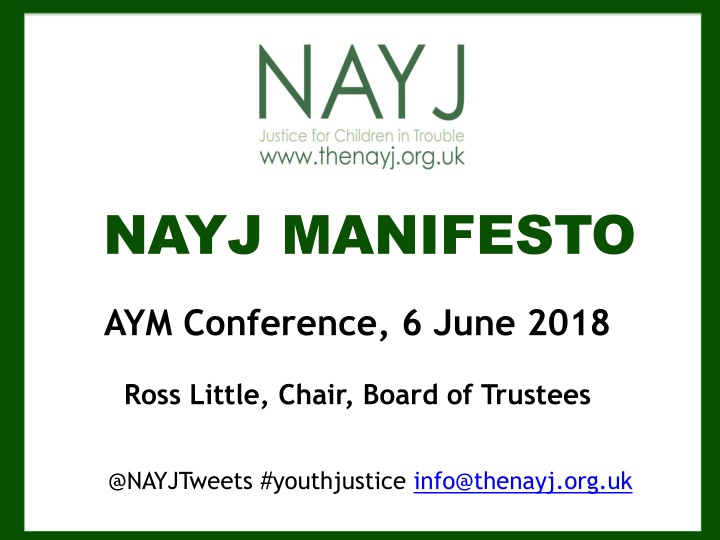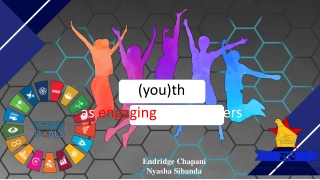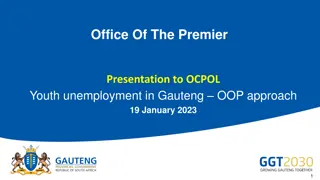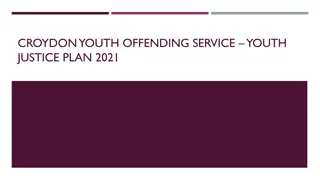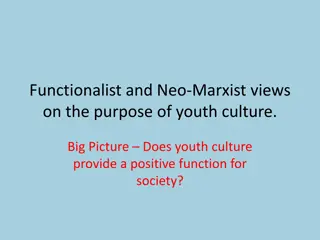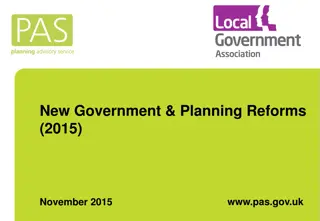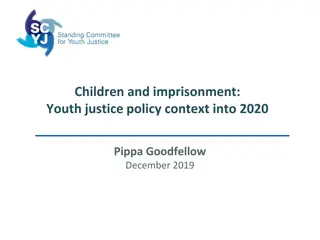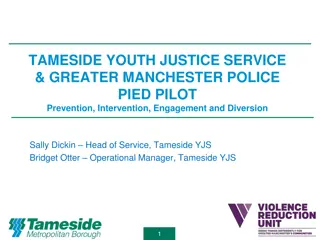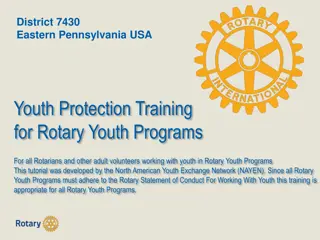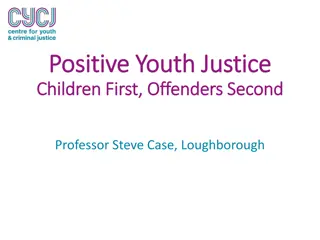NAYJ Manifesto for Youth Justice Conference
NAYJ presents a manifesto advocating for the rights and justice of children in trouble with the law. Emphasizing child-friendly responses, the manifesto calls for distinct arrangements for children, diversion from the criminal justice system, raising the Minimum Age of Criminal Responsibility, and a children-first approach. It promotes ethical and evidence-based youth justice interventions, recognizing the social injustices affecting vulnerable children.
Download Presentation

Please find below an Image/Link to download the presentation.
The content on the website is provided AS IS for your information and personal use only. It may not be sold, licensed, or shared on other websites without obtaining consent from the author.If you encounter any issues during the download, it is possible that the publisher has removed the file from their server.
You are allowed to download the files provided on this website for personal or commercial use, subject to the condition that they are used lawfully. All files are the property of their respective owners.
The content on the website is provided AS IS for your information and personal use only. It may not be sold, licensed, or shared on other websites without obtaining consent from the author.
E N D
Presentation Transcript
NAYJ MANIFESTO AYM Conference, 6 June 2018 Ross Little, Chair, Board of Trustees @NAYJTweets #youthjustice info@thenayj.org.uk
NAYJ Only individual member organisation which campaigns exclusively for the rights of, and justice for, children in trouble with the law. Promote welfare of children in the YJS in England Advocate for child friendly responses where children infringe the law.
DISTINCT ARRANGEMENTS FOR CHILDREN Children distinct from adults Ethical and evidence-informed arrangements LT healthy development May also involve working with family All professionals should be child specialists
MAX DIVERSION FROM CJS AND ACCESS TO MAINSTREAM SERVICES Involvement with CJS itself increases risk of re- offending Entitlement to full range of m/stream services Absence of services makes difficult situations worse for vulnerable children CJS involvement sometimes leads to reduced m/stream services FTE target is welcome; also need signposting to other appropriate support
RAISE THE MACR MACR out of line with other domestic legislation re. safeguarding Out of step with international practice and rights based obligations (UNCRC: 12 years = lowest compatible age) Growing out of crime Align with age of consent (16) Maturity
CHILDREN FIRST APPROACH Responses should primarily reflect child status rather than offender status ST measures of re-offending are inadequate and inappropriate Children have a right to anonymity Wipe the slate clean in most cases
ETHICAL AND EVIDENCE- BASED YJ interventions should be determined by Principled decision-making informed by evidence-based understanding of why children engage in problematic behaviour Recognise problems with CJS contact Understanding how maturation process can be assisted
ACKNOWLEDGING SOCIAL INJSTICE Arrangements underpinned by understanding that most children in trouble with the law might be seen as victims of forms of social injustice/disadvantage Evidence of victimisation-offending relationship YJ interventions should attempt to address social disadvantage
NO PUNISHMENT FOR CHILDREN Retributive responses are unethical, inappropriate, unnecessary and ineffective YJ interventions determined on basis of just welfare Designed in best interests of child for max well-being Ltd by considerations of proportionality
ENGAGEMENT THROUGH PARTICIPATION Participatory approach should be central to all interventions Children involved in goal setting, supervisory process and resettlement process
CHILD-FRIENDLY COURTS No child should be tried in an adult court Court rooms and processes should be child friendly; involvement of child Decision-makers (and others) should be child specialists Generally, attend in person. Video link only used if no substantive decision and child does not wish to attend
CUSTODY AS LAST RESORT Custody should be used only as a last resort. Incarceration is damaging. Ineffective at reducing re-offending. Strong presumption that intervention should be in community.
CHILD CARE ESTABLISHMENTS only. Used where custody unavoidable. Managed in accordance w Children Act duties & regs and provided by Children s Services Dept. No child detained in Police stations overnight Prison Service establishments Custodial institutions run for profit Small units, close to family, high staff:child ratios, access to m/stream and specialist services
EQUALITY OF TREATMENT Over-rep n of children from minority ethnic communities Recent reductions in FTEs not experienced equally National target for YJ agencies to reduce disproportionality Multi-agency strategy to monitor and ensure equality of treatment Lammy Review recommendations
PUBLICATIONS @NAYJTweets info@thenayj.org.uk www.thenayj.org.uk
NAYJ COMPENDIUM 2018 @NAYJTweets info@thenayj.org.uk www.thenayj.org.uk
